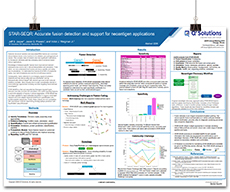
STAR-SEQR: Accurate fusion detection and support for neoantigen applications
The update of STAR-SEQR to report extended annotation in support of neoantigen research
Genomic structural variation and associated RNA fusions are a common clinical feature known to be involved in the initiation and pathogenesis of cancer. This complex class of variants also has significant implications on therapeutic decisions and has emerging roles in evidence-based clinical applications.
Knowledge of disease-specific fusions have improved and several databases now exist to aid in clinical interpretation and annotation. From which, we now understand that fusions aretissue-specific and widely vary in prevalence. It is estimated that fusions drive 90% of lymphoma cases, over half of leukemia and one third of soft tissue tumors.
Consequently, fusion detection is an emerging aspect of precision medicine and has clinical utility both as a biomarker and as therapeutically relevant target with several approved small molecule inhibitors available. More recently there is also considerable interest in immunotherapy approaches including vaccines targeting fusion-derived neoantigens.
This poster highlights STAR-SEQR, a fast and accurate tool that goes beyond fusion detection and also provides rich annotation and useful reporting features to aid in the adoption of fusions in clinical diagnostics. STAR-SEQR has now been updated to report extended annotation to support neoantigen research and now outputs transcript-level fusion quantification and junction peptide sequences. These outputs are now compatible with downstream tools for determining binding epitope prediction with HLAProfiler and pVACtools.
Authors: Jeff Jasper, Jason Powers, and Victor Weigman
Complete the form below to access this scientific poster








